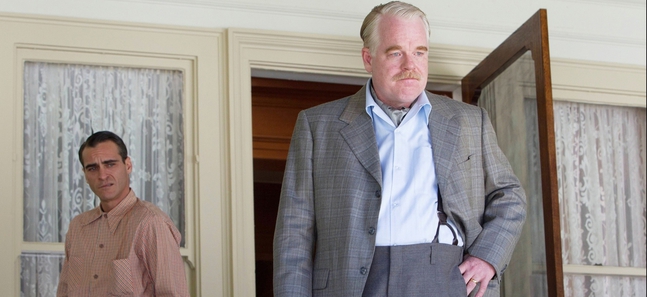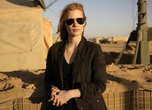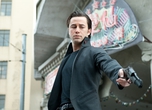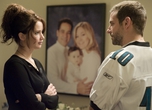The Master
Paul Thomas Anderson finds rich drama in the early days of Scientology

© MMXII by Western Film Company LLC All Rights Reserved.
Posted: Tue Feb 19 2013
Director: Paul Thomas Anderson
Starring: Joaquin Phoenix, Philip Seymour Hoffman, Amy Adams
Time Out rating: 
Paul Thomas Anderson’s The Master riffs on the early roots and allure of Scientology with the same compelling strangeness and heady intensity that the American writer-director of Boogie Nights and Magnolia brought to his last film, There Will Be Blood. The Master is another tale of warped power and fanatical delusions, and it sees Anderson on captivating form as a director who is able to surprise and impress with scene after scene.
Some of the pre-release talk about The Master sought to distance its gaze from Scientology, but the film is less equivocal: the organisation depicted here by Anderson may be called The Cause and its leader Lancaster Dodd (played with a frenzied, red-nosed exuberance by Philip Seymour Hoffman), but Dodd is clearly modelled on L Ron Hubbard, from his physical appearance and his eccentric theories to his claims to be a writer, a scientist and much else besides. The parallels are many, and the disguise is so thin as to barely exist.
But you can understand why Anderson didn’t want to get too bogged down in facts. His interest is as much emotional and psychological as historical. He creates a totally beguiling character, Freddie Quell (Joaquin Phoenix), to lead us in and out of Dodd’s bizarre world. We meet Quell at the end of World War II, a disturbed sailor obsessed with drinking and sexual fantasies (images of him and colleagues frolicking on a beach look like a Bruce Weber photo shoot gone rogue). Phoenix plays Quell with an alienating intensity; he’s unpredictable from the first frame to the last.
It’s through Quell that we meet Dodd, an amiable patriarch and leader of a small band of followers afloat on a ship, who takes this unhinged loner under his wing, and applies to him the methodology of The Cause, indulging his troubled mind and propensity for violence. Most of the drama unfolds over a few months in 1950, first on the boat and later at the house of a patron in Philadelphia, although scenes of Quell going through ‘processing’ (an intense form of analysis) inspire flashbacks to earlier days.
The Master is driven by a spare, jaunty and eccentric score by Radiohead’s Jonny Greenwood. Anderson dominates the rarely-used 65mm format – his close-ups are overwhelming and his longer shots are deep and layered, even seeming 3D-like at their most inventive, with colours and detail brilliantly evoked. Hoffman and Phoenix are at the top of their game, with Phoenix giving a hunched, deranged turn that flits between a childish search for acceptance and a hair-trigger air of violence.
As a depiction of a burgeoning religion, it’s like a portrait of Jesus from the perspective of one of the lesser known disciples: the Gospel According to Quell. We learn that Dodd is a bacchanalian figure, fond of fun and power, prone to extreme anger when challenged and adept at extracting funds and time from his loyal supporters. Anderson asks: why do men such as Dodd and Quell come together? What do they need from each other? How do they sustain each other’s fantasies?
His answers partly lie in a portrait of the needy meeting the powerful. But there are also suggestions of more inscrutable psychological and sexual motives for such alliances. It’s also a commanding portrait of America at a very particular point in time: Anderson may keep his drama close to a few key characters, but he also offers a strong, disturbing sense of a world turned upside down by war and of a chaos that allows the strange new order of The Cause to emerge.
The Master opens at select cinemas nationwide on March 22
Tweets
- About Us |
- Work for Time Out |
- Send us info |
- Advertising |
- Mobile edition |
- Terms & Conditions |
- Privacy policy |
- Contact Us
Copyright © 2014 Time Out Tokyo














Add your comment